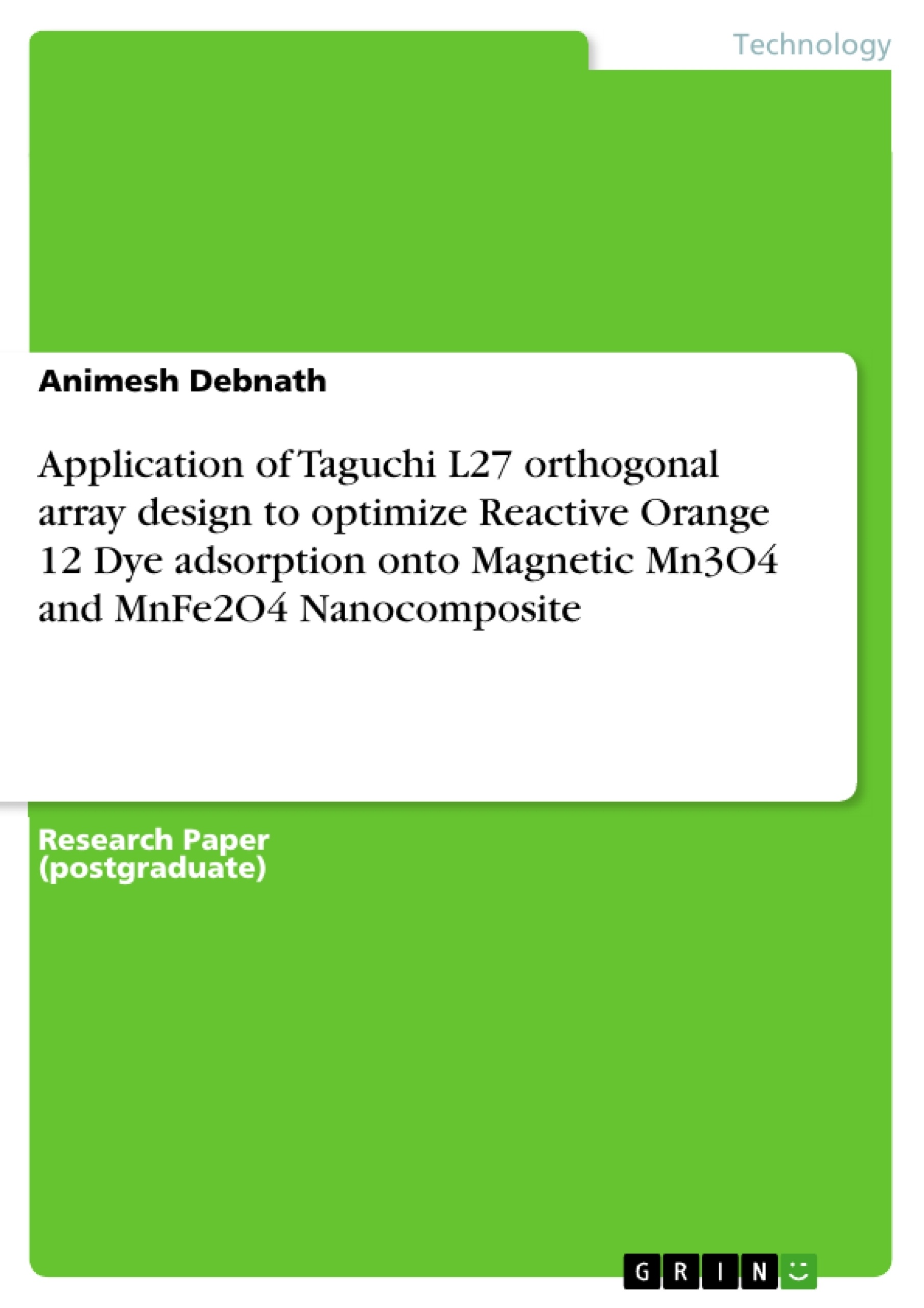In this study, Taguchi L27 experimental design was utilized to optimize adsorption of Reactive Orange 12 (RO 12) dye onto magnetic manganese oxide and manganese ferrite (MO-MnF) nanocomposite. The MO-MnF nanocomposite was characterized by X-ray diffraction (XRD), scanning electron microscopic (SEM), Fourier transform infrared spectroscopy (FT-IR), and vibrating sample magnetometer (VSM) measurements.
The experimental design was constructed with five factors (solution pH, RO 12 dye concentration, MO-MnF dose, contact time, and reaction temperature) at three different levels. The experimental conditions were optimized to maximize the RO 12 dye removal efficiency where signal-to-noise (S/N) ratio was considered as criteria. Optimum values of 2.0, 1.0 g/L, 60 min, 50 mg/L and 60°C were obtained for solution pH, MO-MnF dose, contact time, concentration of RO 12 dye, and reaction temperature, respectively for maximum RO 12 dye removal efficiency of 99.32%. This adsorption process proficiently followed pseudo-second-order and intra-particle diffusion models and exhibited applicability of Langmuir monolayer adsorption with maximum adsorption capacity of 207.90 mg/g at room temperature.
Table of Contents
- INTRODUCTION
- EXPERIMENTAL DETAILS
- Materials and methods
- Synthesis and characterization of MO-MnF nanocomposite
- Taguchi design of experiments
- Results and discussions
- Characterization of MO-MnF nanocomposite
- Optimization of RO 12 dye adsorption using Taguchi L27 orthogonal array
- Effect of process variables on RO 12 dye adsorption efficiency
- Analysis of variance (ANOVA) for the adsorption parameters
- Adsorption kinetics
- Adsorption isotherms
- Thermodynamic studies
- CONCLUSIONS
Objectives and Key Themes
The study aims to optimize the adsorption of Reactive Orange 12 (RO 12) dye onto a magnetic manganese oxide and manganese ferrite (MO-MnF) nanocomposite. The optimization is achieved using Taguchi L27 orthogonal array design, minimizing the number of experiments and maximizing efficiency. The study investigates the influence of various factors on RO 12 dye removal efficiency and determines the optimal conditions for maximum removal.
- Optimization of RO 12 dye adsorption using Taguchi L27 orthogonal array design.
- Characterization of MO-MnF nanocomposite using various analytical techniques.
- Analysis of the influence of process variables on RO 12 dye adsorption efficiency.
- Application of adsorption kinetics, isotherms, and thermodynamic models to understand the adsorption mechanism.
- Evaluation of the potential of MO-MnF nanocomposite as a cost-effective and efficient adsorbent for dye removal from wastewater.
Chapter Summaries
The introduction outlines the problem of industrial effluents containing toxic synthetic dyes, focusing on azo dyes and their environmental and health hazards. Reactive Orange 12 (RO 12) dye, a widely used anionic dye, is highlighted for its toxicity and the need for efficient removal methods. The chapter discusses the advantages of adsorption as a treatment technique and the potential of nano-sized adsorbents for dye removal. The study utilizes magnetic nanoparticles for ease of separation and recovery.
The experimental details section outlines the materials and methods used in the study, including the synthesis and characterization of MO-MnF nanocomposite. The Taguchi L27 orthogonal array design is described as a tool for optimizing the adsorption process.
The results and discussion section presents the characterization of the MO-MnF nanocomposite using X-ray diffraction (XRD), scanning electron microscopic (SEM), Fourier transform infrared spectroscopy (FT-IR), and vibrating sample magnetometer (VSM). The optimization of RO 12 dye adsorption using the Taguchi design is detailed, including the effect of process variables and analysis of variance (ANOVA) for the adsorption parameters.
The adsorption kinetics, isotherms, and thermodynamic studies are discussed, providing insights into the adsorption mechanism.
Keywords
The study focuses on the adsorption of Reactive Orange 12 (RO 12) dye onto magnetic manganese oxide and manganese ferrite (MO-MnF) nanocomposite using Taguchi L27 orthogonal array design. Key topics include adsorption, dye removal, magnetic nanoparticles, Taguchi optimization, and environmental remediation.
- Arbeit zitieren
- Animesh Debnath (Autor:in), 2016, Application of Taguchi L27 orthogonal array design to optimize Reactive Orange 12 Dye adsorption onto Magnetic Mn3O4 and MnFe2O4 Nanocomposite, München, GRIN Verlag, https://www.hausarbeiten.de/document/377869


